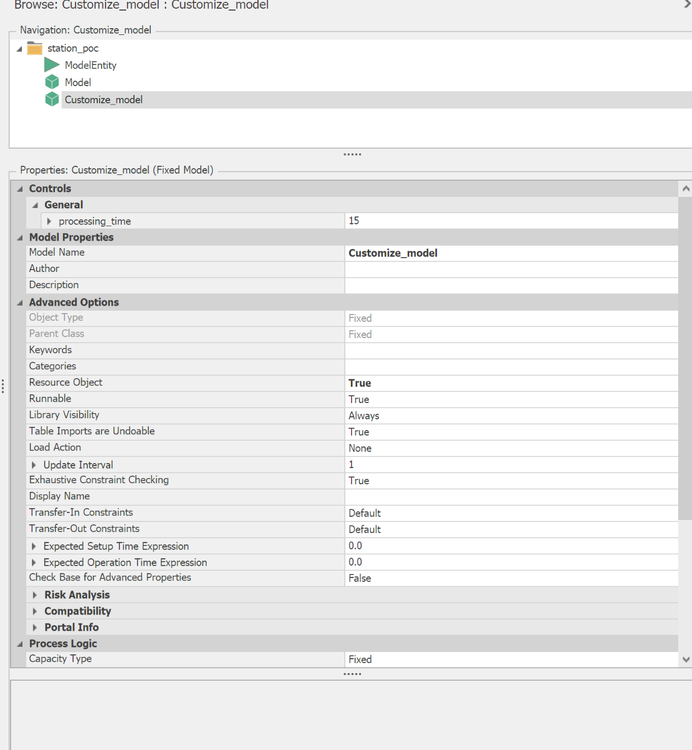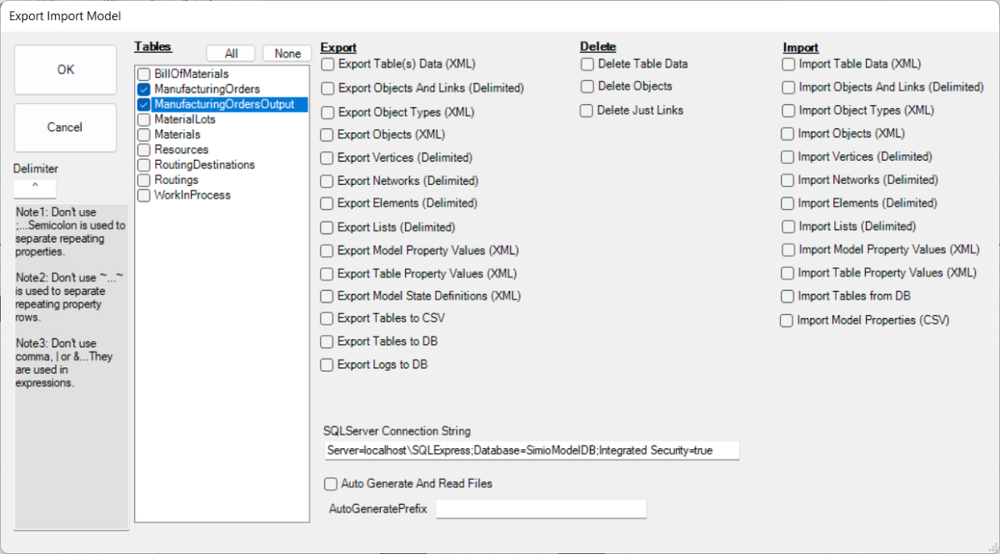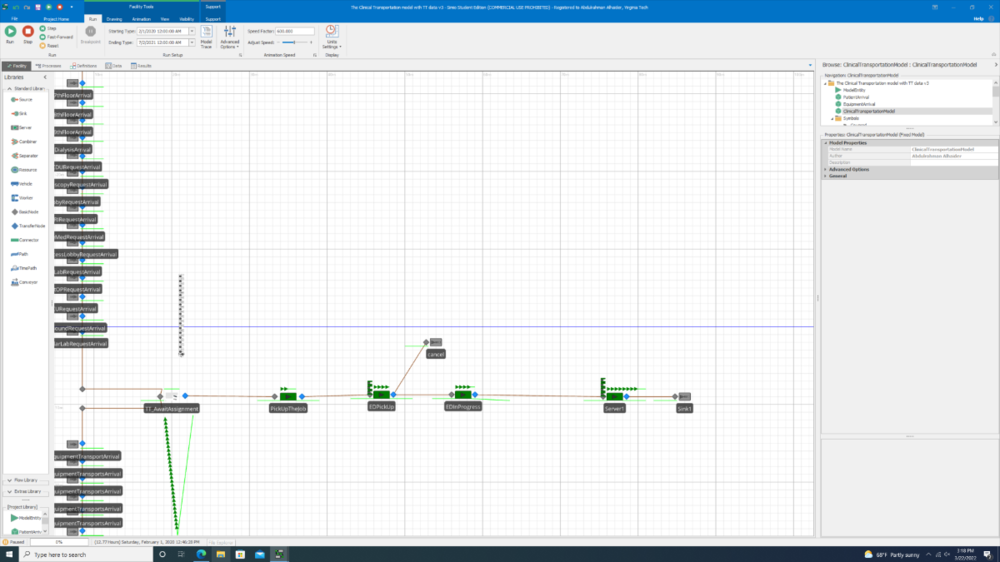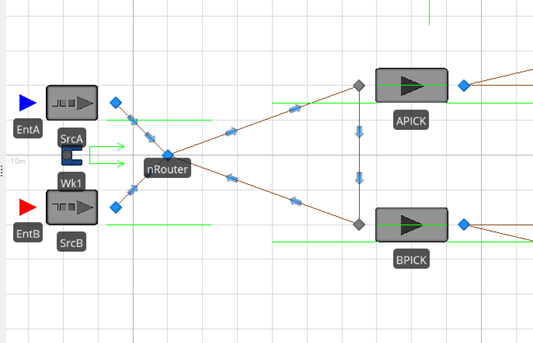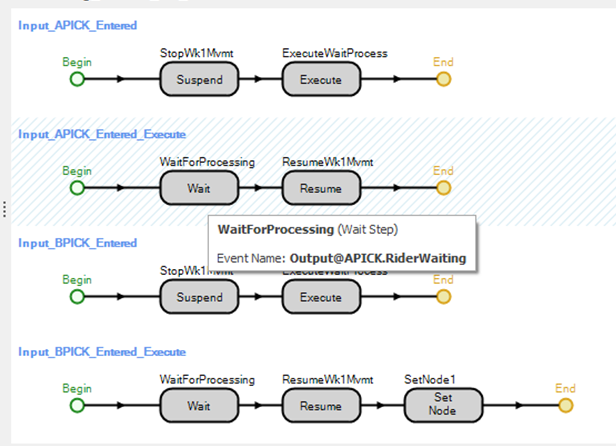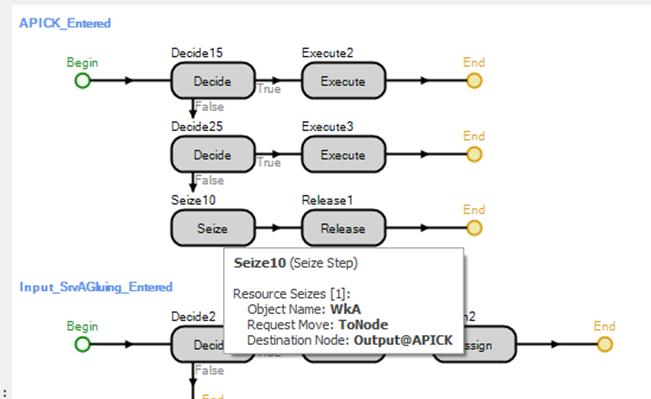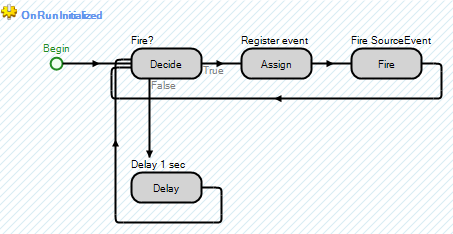Search the Community
Showing results for 'find process'.
-
Hello everyone, I am creating a new "customize" model and try to enable addon process, but I cannot find this option in the following list.
-
Here is a simple utility that will export, import and delete artifacts of your model. Here is a screen shot of the available capabilities. The code and DLL have can be found on SImio GitHub. Please find at this link: https://github.com/SimioLLC/ExportImportModelAddIn You will also find install instructions in the ReadMe. Here are the changes that have happend over time: Updated 2023-01-31....Added the ability to select multiple tables for export and delete table data functions. Updated 2022-10-05....Updated the exports to sort the data first my name and then export. This ensures that the data exported is in a consistent order. Updated 2021-12-07....Added the ability to select a table and then remove the data from the selected table. If a table name is not selected, all the tables in the model will have their data removed. Updated 2021-09-20....Added Update Model Properties (CSV). With this new method, you can import model properties into your model. If the file contains 3 fields...First is name, then type and last is default value. The only valid types are real, datetime, Boolean and everything else is string. If the model property already exists, it will only update the default value on the property. Note: The example assumes the field separator is a caret '^'. To change this, you need to change the delimiter field. Updated 2021-09-08....Updated the sequence of the exports, deletes and imports happen. When OK is pressed, first the exports are run, then deletes and finally the imports. With this change, I am able to Export Table to DB, Delete Table Data and Import Table from DB from in a single run. I typically do this when re-mapping auto creates elements. Since the table data need to be removed and recreated before mapping of the elements are correctly mapped. Updated 2021-09-06....Upgraded to .NET 4.7.2. Also, fixed the windows form so it displays correctly. When opened, the form should no longer need to be expanded to see all the options. Updated 2018-11-08....Added Export To CSV, Export To DB and Import From DB. Export To DB will create a table in the SQL Server database with the same table name as the table in Simio. The data columns will be of type nvarchar(max) and the default value will be the same as the default value in the Simio table. It is assumed that Simio desktop will still do the data validation, not the database. This feature is used to save the Simio data into a database so it is backed up and can be shared across users. Each time the Export To DB, if the table already exists, it is dropped, and a new table is created. This ensures that the data schemas match between the Simio model and the SQL Server database. Updated 2017-12-05....Fixed index issue with links import. Updated 2017-09-25....Fixed the import of lists. Updated 2017-07-14....Added the ability to auto generate and auto read files. Previously, the files needed to be created prior to running the add-in. Now, they will create by the export. Also, the import will retrieve the same file generated by the export. These options are available when the "Auto Generate and Read Files" option is selected. Updated 2017-07-13....Added the ability to multi-select options. Now, more than one option can be initiated when the OK button is selected. This will streamline the process of exporting, deleting and importing. This tool is very helpful for testing out your model with various configurations to ensure that runs properly under various object and/or data configuration. Updated 2017-07-11....Now supports exporting and importing of model properties, exporting and importing of table properties and delete table data. Updated 2017-06-22....Now supports exporting and importing of data tables using XML. This is simple way to export all the table data from one model and import the same data into a new model (assuming that the same tables schema exists in the new model). Updated 2017-01-27....Now supports exporting of object types using XML. This can be used with the new Configure Scheduling Resources in Simio 9.150 capabilities to define your own object type properties based on an XML document. Updated 2017-01-23....Now supports exporting and importing objects using XML. When using XML, property units are also exported and imported back in. Updated 2016-10-24....Updated files...Added support for repeating properties.
-
Hello, I'm working on a problem where at some point a worker will transport a specific amount of pallets. Whereafter these pallets are processed by a server and a server wil process them. Once processed, a different worker (or the same worker) will move the pallets to the next server. How do I save these entities as a batch and let workers know how much pallets they can process? At the moment I have two approaches. One where I create a 'batch' as an entity and assign to it the amount of pallets. The 'problem' in that case is that I do need to count the amount of pallets at a server, since it has a certain capacity. And sometimes an initial batch whitch comes from a truck needs to be split to fit the capacity of workers. But once this would be fixed, the worker will always transport the right amount of pallets. A second approach that I have tried is to create the pallet entities normally, and assign a 'PalletHistory' in the modelEntity properties, but I find that after processing I can't find this palletHistory for the workers to get a sign of how many pallets to transport. Do any of you guys have an idea how I can approach this? Greetings
-
Hey Simio insiders, I'm a Simio beginner and am doing my first big Simio project. I am modelling a docking system. Trucks arrive at docks with a certain amount of pallets/trolleys. The trucks dock and after a worker inspects their shipment, the trolleys or pallets will be transporter by the worker to the next area. Since there are multiple trolleys in a truck the worker will first transport the exact amount of trolleys (more than 1) to the next area. I cant find how to increase the capacity of a single worker and how to assign a precise amount of trolleys (temporarily) to process/transport. Thank you for your help
-
Hi, I have an issue related to workers going off-shift and abandoning the reserved entities in different servers, depending on when the shift change happens (picture attached is an example). The shift change is based on switching from Worker of x number of population to y number of population to meet my WorkSchedule. The Worker should always carry different entities throughout, entities cannot travel alone. The logic issue happens as a result of entities left in servers or buffers that were not picked up by workers due to the end of shifts, causing too many objects/entities in the system not destroyed. An expert suggested to build process that checks the Worker's Allocation Queue when it goes off shift to see if there are any entities in it, and if there are, turn the Worker back on shift. I tried to build that process, but I could find the right steps. Any help on identifying the right steps or a different way to model workers shifts is appreciated.
-
I am trying to make a routing decision based on the Candidate node's routerequestqueue's summation of the entities user-defined property. If there are different types of entities with ex. different priority levels. I would like the routing process to choose the transfernode which has the smallest total sum of it's entities priority level. the transfernode that needs to be chosen also has a routing group attached to its entity destination type rule where its final machine has 0 buffer and due to a blocked destination rule, there will be a queue build up at the transfernode that needs to be chosen. I have thought about using a state variable for each node and using add-on process each time a unit enters and leaves a node but because the main model has many multiple nodes the node's entity priority sum has to be able to be accessed through the candidate.transfernode._________________. For example during the routing step in the process section, I have candidate.transfernode.destinationroutinggroupname.routerequestqueue which gives me the node's number of units waiting, but i need to be able to access the candidate nodes summed queued property. Is there either a way to directly access this information, have looked at the expressions and having a hard time finding something. failed attempt: candidate.transfernode.destinationroutinggroupname.routerequestqueue.population.defaultentity.priority.summation or is there a way to use the add-on process where i am adding/subtracting the priority levels, but somehow attach it to the candidate.transfernode's property Hopefully this makes sense. If you look at the file, please ignore the upper half and focus on the transfer nodes maintransfer, transfernode1 and transfernode1_1. maintransfer has an entered add-onprocess which is the subject of this question. the route process and it's selection expression is what I'm trying to adjust but find a way to express the candidate transfernodes of transfernode1 and transfernode1_1 (which are part of the XferRouting group). I'd like to choose and compare the total summed priority level of each node's queue. Simple_Routing.spfx
- 2 replies
-
- routing
- expressions
-
(and 2 more)
Tagged with:
-
Senior Industrial Engineer - Simulation Req #: 67308BR York, Pennsylvania, United States Engineering & Technology Platforms & Services Posted on:03/29/2021 Job Summary Career Level Experienced Travel Percentage 10% Full-Time / Part-Time Full-Time Clearance Level - Must Currently Possess None Shift 1st Shift Relocation Available Yes ITAR: U.S Citizen or Green Card Required Yes Clearance Level - Must Be Able to Obtain None Job Description What motivates you? If the answer is a position where you can develop your skills and earn opportunities for advancement while being part of a forward looking team then this is what awaits you in a career at BAE Systems. Our employees work on the world’s most advanced combat vehicle systems. From the M109A7 Mobile Howitzer with its long range firepower to the Amphibious Combat Vehicle that transports America’s Marines from ship to shore, we are developing the technology of tomorrow while delivering the most cutting-edge equipment available today. Our flexible work environment provides every opportunity to positively impact the company without giving up your personal life and we welcome all those who understand the importance of improving production velocity, having big ideas, and craving innovation. We draw strength from our diversity and always put our customers first through an unwavering commitment to bring the warfighter home safe. Does this sound like a team you want to be a part of? If so, come build your career with BAE Systems. The Combat Vehicles line of business within the Platforms & Services (P&S) Sector of BAE Systems is looking for a self-motivated Senior Industrial Engineer to support the production scheduling of armored military vehicles. Working as a team member of a larger Industrial Engineering Group, this Engineer will be required to build and maintain simulations for varied fabrication, assembly, and testing processes. The candidate must also be comfortable with soliciting input through face to face interaction and, in general, must demonstrate that they possess strong analytical, problem-solving, and interpersonal skills that will support individual and team growth. A strong background in discrete event simulation, specifically with the use of SIMIO, is necessary. Specific responsibilities include: Day-to-Day · Complete simulation support activities such as time studies, production line balancing and production metric development · Evaluate complex Technical Data Packages (Drawings, Bills of Material) and be able to understand how a component or vehicle is assembled · Utilize a strong understanding of integration activities like implementation of standard work, material kitting, metric tracking, and process improvement to advance manufacturing methods. · Work on the manufacturing floor with other Engineering disciplines, production supervisors, and employees that directly interact with the components or vehicles being produced. Internal and External Customer Relationships · Engage in regular communications with production support, planning, logistics, quality, manufacturing supervisors, and direct labor workforce to assess operations performance. · Summarize and present findings to internal customers to gain buy-in for improvement efforts · Discuss the status of metrics and key performance indicators with appropriate decision makers Development · Work with Industrial Engineering leadership to understand the expectations of new Engineer within the organization and company · Share responsibility of self-development with immediate supervisor · Maintain a safe work environment and ensure compliance with safety objectives and policies. Required Education, Experience, & Skills - 4+ years of simulation experience within SIMIO - BS degree from an accredited university Preferred Education, Experience, & Skills Demonstrated capability with the use and application of SIMIO discrete event simulation software. About BAE Systems Platforms & Services BAE Systems, Inc. is the U.S. subsidiary of BAE Systems plc, an international defense, aerospace and security company which delivers a full range of products and services for air, land and naval forces, as well as advanced electronics, security, information technology solutions and customer support services. Improving the future and protecting lives is an ambitious mission, but it’s what we do at BAE Systems. Working here means using your passion and ingenuity where it counts – defending national security with breakthrough technology, superior products, and intelligence solutions. As you develop the latest technology and defend national security, you will continually hone your skills on a team—making a big impact on a global scale. At BAE Systems, you’ll find a rewarding career that truly makes a difference. The Platforms & Services (P&S) sector under BAE Systems, Inc does the big stuff: the armored combat vehicles, naval guns, missile launchers, and naval ship repair…just to name a few. Our employees take pride in the work they do and why they do it. They are on the front lines every day, building our products to protect the lives of those who serve. We may be biased, but we think P&S does some of the coolest work around, and we think you will too. At BAE Systems, we celebrate the array of skills, experiences, and perspectives our employees bring to the table. For us, differences are a source of strength. We’re laser-focused on high performance, and we work hard every day to nurture an inclusive culture where all employees can innovate and thrive. Here, you will not only build your career, but you will also enjoy work-life balance, uncover new experiences, and collaborate with passionate colleagues. https://jobs.baesystems.com/global/en/job/67308BR/Senior-Industrial-Engineer-Simulation Thanks, Jenny Ridings, PHR Principal Talent Acquisition Specialist BAE Systems My pronouns are she / her M: +1 904 570 2489 | E: jenny.ridings@baesystems.com https://jobs.baesystems.com Connect with BAE Systems: Join our talent community!
-
Entity Distance travelled on Transporter
Liz Millar replied to ttarkan's topic in SI General Discussions
I would recommend using a Data Table. One column could have all your entity types defined. The next column could be a Tally Statistic Element Reference Property. This column would match up the Tally statistic you want to correspond with the Entity Type. You could choose to auto-create these Tally Statistics from the Data Table. If you change the Tally Statistic Property's column Reference Type property from 'Reference' to 'Create', this will make the Tally Statistics for you. I recommend the Help page "Table-Based Elements (Auto-Create)" in Simio for more information. If your Entity Instances noted in the Data Table are unique, no duplicates, you can set that column as a Key. With that column as a Key, you could use just the Tally step and use the RowForKey expression. RowForKey will allow a key input to search for in that column. If the model entity is driving the process, you could use an expression like this for the Tally Statistic Name 'Table1[Table1.EntityInstanceProperty1.RowForKey(ModelEntityReference)].TallyStatisticProperty'. Since it seems this process will be on the OnRunEnding, it will not have a reference to a specific entity, so you will most likely need a Search step to find the entities still in the system. I would set the Search step to find Infinite things and let each entity reference exit on the found branch. If the EntityInstanceProperty column in your Data Table has the Auto-set Table Row Reference property to 'True', the entities will already know the row reference and your Tally step Tally Statistic Name property could be 'Table1.TallyStatisticProperty'. -
Hi Jason, I recommend using a Notify step with the expression Token.AssociatedObject.Name prior to your Assign step. This will read out the associated object that is executing the process with your Assign step. It might be that the Entity is not the object executing that process. If your entity is not executing the process, you might want to find another process trigger or Search for the entity in the population. If its a process that could be triggered by an entity, or another object, say a Worker, you could start your process with a Decide step that filters out the non-ModelEntity objects. This could be as simple as checking 'Is.ModelEntity' with the Decide step. Happy modeling, Liz
-
Note: WkA and WkB essentially do the same thing, so I'm essentially just explaining WkA on the seizing worker to make things simpler. What needs to happen: I need Wk1 to wait until WkA is at the output node before processing the entity. Then resume movement (to go to input of BPICK) only after the event of Output@APICKRiderWaiting (basically the processing finished; I found it only works when I use the wait for rider waiting). The same thing needs to happen with BPICK. Then Wk1 needs to head back to nRouter. Current State & Problems: Right now it does not wait to process the entity until WkA/B gets there. I have tried adding that as a row in the events more logic, but it doesn't work. I have also tried putting a Wait step with that as it's event before the other Wait. However, Wk1 still gets to APICK/BPICK and immediately the entity is processed. Wk1 does however work on not moving on until the entity is processed. One problem with that though is that Wk1 does not go back to nRouter after finishing at BPICK. I have tried several things like setting node, but perhaps I didn't have that step in the right place. Both entities have a destination by the way. This next photo is showing the seizing of the worker. The decide and execute steps refer to interrupting processes but all those still include the seizing step you see here. I have also attached my model in case you need to run or see it. It may be hard to follow all the logic on other add-on processes other than the ones I showed you. I have other problems in other areas, but this problem I'm posting about is not that affected by the other problems of the model I think. Though honestly, if you find that you may have a solution or fixes in basic logic to those (because its glaring) then by all means, share them. ((And yes, I have looked at InterruptibleOperator simbit as well as other Interrupting example simbits but am still confused on the whole thing.)) ModelForQuestionCOPY5v.3.spfx Thank you!
-
Process Logic Design for Data-Generated Models
oalotaik replied to oalotaik's topic in SI General Discussions
Thanks Adam for the reply. I know a fair amount about Processes; I just needed a clarification about some aspects related to large models created using tables. The example I mentioned in the original post may be simple but it could easily scale to include 100's of locations. I will give some examples of these aspects that get tricky in such large models below. Thanks Glenn for the clarification. The tip about finding where processes are being referenced in a model is great! The MultiEchelonSupplyChain example may look simple, but it has the potential to be complex. When I asked the question what I had in mind is a similar model but with 100s of locations like DistributionCenter and Retailer (Basic Nodes). Imagine you want 300+ basic nodes (like in my case) to have the same add-on process. Imagine having 300+ inventory elements that you want to write statistics for using a Write step. It's tedious to do things manually. As for referencing the same add-on process for 100s of objects (basic nodes in my case), I found a trick, which is to add the add-on process to one of the objects and then sub-class it so that the process becomes a default for the newly sub-classed object. Then change all the other objects to the new sub-classed object. As for writing statistics for 300+ inventory elements, I couldn't find a way to automate the process. To be clear, I want (for each inventory element) to write statistics at various points throughout the simulation run. The standard reported stats for inventory elements are only "Totals" or "Averages" or a function of the two. What I want is to see how a statistic changes over time, so I need to write to a CSV file using a Write step. When working with large models, there's a need for automating some modeling aspects. Creating objects and elements can be easily automated using tables. It's dealing with these created objects and elements that sometimes needs tricks and workarounds to automate. -
I am building a model where I need to use relational data tables to create objects and elements due to the large size of the model. I found helpful resources to guide me when it comes to auto-creating objects and elements (Simio Help Guide, SimBits, and Examples). But for some reasons I couldn't find resources that address directly the topic of process logic design in data-driven models. There is one particular example that's very relevant to my case. This example is MultiEchelonSupplyChain that comes with Simio (in Simio: Support > Examples > MultiEchelonSupplyChain). This example is solved using two approaches. The second one (the data-driven approach) is the one I'm interested in. In the accompanying PDF file that explains the technical details of the example, it does not explain the differences in process logic design. For example, how do I define triggering events? Some of the processes in this example have no triggering events. If you know of a resource that explains designing processes for data-driven models, please share. Thanks.
-
Only create Entities of certain part of ArrivalTable
Mirek replied to Mirek's topic in SI General Discussions
Hi gocken, I think the second approach will be impossible with my huge DataTable. I think I need to find a way to point to the right row or try with the interarrival time mode. At first I thought of implementing a further Table with a Column key = IntegerProperty1 and then in a process Set the row in this table to IntegerProperty1. I thought in this case it should only point to the right rows in Table1. -
As we approach our final stage of our bachelor studies, it is necessary to write a bachelor thesis. In this context we are developing a Simio Plugin, which enables advanced model-management and more important, model-comparison. Our main objective is to provide the Simio Community a properly working Plugin, which improves the modelling process itself and the usability within large Simio-projects. What could you expect? Functionality We separate the plugin in two logical components. The first one is called Modelmanagement. The features of this component are the following: • Versioning models • Clone an existing model The interesting part on this feature is the clone mechanic. You are now able to create an identic clone of an existing Simio-model, which can be altered afterwards. This functionality is key to the comparison process. With this clone-function, each clone now represents a version of your base-model. The clones can be altered autonomically. It enables to test and experiment with the behavior of your model, without many workarounds. It may help you to even optimize your model. The second and more focused feature is the ModelComparer. Once you are done cloning and altering your models, this feature helps you to compare several experiments. The comparison isn’t only limited to experiments within one model, you can compare all the cloned experiments as well. Our model-comparison compares responses of several, different experiments. You can now compare all your clones to determine which one is the most efficient. What are we delivering at this point and why? Attached to this post you can find several files. To ease the installation and setup process of the Plugin, we also created an installer. The installer will setup the required changes and files for our Plugin. It is easy to use and enables the full functionality, like a normal software-installer. Second, we wrote a short manual to show you the features of the Plugin and illustrated it with pictures. Our goal is to gahter feedback as early as possible. Currently, we are in the middle of development and are eager to improve the tool even more. We ask you for your feedback, because it is very important for us to find out, if the tool is viable, how its usability is and if the provided functionality is even appreciated within the community. As we mentioned we are halfway through the development-process, the possibility is given, that some bugs or errors may occur. We also would be very pleased if you could take the time to report these and your experience with the tool and fill in the online survey. Your feedback is very appreciated! Link to the online Survey: http://30raqy.findmind.ch Thank you, Philipp Bütikofer Anthony Delay HSR - Hochschule für Technik Rapperswil Oberseestrasse 10 8640 Rapperswil ModelComparison.zip UserManual.pdf SimioToolsInstaller.zip
- 1 reply
-
- 1
-

-
Hi George, I know the normal ways, to create an entity from a table are: 1) Use a timer with the date/time table for a trigger for a own process or 2) A source with the arrival table option. If you want to create entities, maybe you can make a loop process like GFurtado with an Read-Step/Excel-Step and then you can use the Create-Step of Simio. Then you can check with an Decide-Step "TimeNow >= value" for example and create your Entity. With this option you can use FastForward too. With an lower delay time it is near the real time. Maybe this could be a solution for your problem. Because, then you dont need a third party tool to click on import. I checked the Simio API and I dont find something about a trigger for the Simio buttons or a button click event, what we can use for the problem. It would be nice, if there is an API to "use" the button click processes. For example, to import one or all tables again. Maybe a professional Simio API developer know more and can write here. Have a nice day! Best regards Pascal
-
At some point I would start looking for a SCADA system, write it in Python or anything outside Simio. A Simio Engineer would be better suited to help you, but I still believe you could build this inside Simio (maybe through an API?). I manage to build a very ugly version of this that kinda works. It's not real real-time, because I still need to click on the manual import button (I don't know how to help you with this). I set my source's Arrival Mode to On Event; Create a process with a Decide step that checks if the table received a new value: If it received a new value, trigger SourceEvent; If it didn't, check again a second later. As I said, it's not very elegant, but I hope it inspires you to find the right solution.
-
Dear all, I am currently working on my master's thesis. The goal is to simulate the waiting line in front of a chair lift at a ski resort. I may have future questions, so I hope we can keep this topic open for other questions on the same model. I started adding objects and need to set the properties for the servers now. Currently I am struggling to find the correct setting that allows me to process entities at a fixed time interval. I want the red barriers in front of the moving walkway to open every 7.2 seconds (interval between two chairs). The servers are called "Schranke" in my screenshot. Moreover, every barrier should open at the same time, i.e. all six servers are supposed to process one entity at the same point of time regardless of its arrival. Thanks for your help! Nico
-
Thanks for your reply! That's something that worked indeed. Although I'd like to model it in a different way. At the moment I am trying to store the location.x of each entity in a vector, and keep this updated by using an add-on process with a loop. From there I would like to let every entity use the find step, to look for the lowest value in the list for location.x - (their own location.x). When this is done, they should switch to a boolean state in which they are trying to "couple". If this is true, these entities will not show up in the previous list with the lowest location.x. When this boolean state is active, I would like to let the entity behind speed up, until the distance between the targeted entity is for instance "1m", after that they should proceed with the same desired speed. I did find some interesting simbits which does something similar like "FindAMinimumStateValue.spfx", although. Instead of updating serverprocessing times, I would like to store the location.x of each created modelentity. Is there any way to do this?
-
Set the buffers to zero...instead of using specifi time for processing, utilize task sequences and set the processing type property to process...I would then look to an add on process to check the stay post a delay.... Note their is a better way to do this with freespace routing, yet I think you will find that more challenging.
-
Hi All, I'm currently using a old working model and copy-pasted a process from another working model. The process uses a couple of assign using ModelEntity State variables. However when I recreate them in the model where I copied the process, I can't use them I always get an error (and orange box). Those State variables were working find in the old model. Anyone knows why I can't copy them in another model ? Tks to all. Janik
-
Greetings! I have this problem and I'm probably doing something wrong. I'm trying to use the Find Step to make my entities look for the closest server through the DirectDistanceTo Expression. This Process is triggered when the entity enters a Transfer Node. Based on these screenshots, can you tell me what am I doing wrong? I'm almost certain the Search Expression is incorrect. Thanks!
-
Hi everybody! I have a server where 3 workers or less are seized at te same time to complete the processing. In the "After_processing" process logic I would like to verify if a resource is indeed seized or not before to try to release it. I tried to use State variables which I give specific values at some strategical steps but I still have failures that occurs once in a while. I have no clue on how to do else. Could someone help me to find a "clean"way to do it ? Thank's in advance! Pierre
-
First define a real state variable to your modelentity named "livingtime" after its creation. Then make a copy of your modelentity and send the copy of modelentity to a process (maybe called as death_process). Place a delay step and set delay time as modelentity.livingtime. Of course the original one should go its way. Then place a search step and find the original modelenity in the system when the time is up at delay step (while finding the original entity you should set a match condition such as candidate.modelentity.ID==modelentity.ID etc. I am not sure whether the ID's of both entities are same, you should try. If it does not work you should try to match creation times of them (both should be same) or any other user defined state variables or properties). If the search is succesful make necessary controls (i.e., if it owned any resource release them etc.) by placing necessary steps following found branch. You should remove and transfer the found modelentity (it is the original one) to appropriate place. At the end you should place a destroy step following the original branch or even transfer it to appriate place. It depends on your goals.
-
There are several ways. One very efficient way to to simply hard code the row number for each object. So if Server7 happened to be a type of machine2 (in row 2) its process time expression could be machineProperties[2].ProcessingTime. A bit more difficult is to use a custom server (call it myServer) that has a myRow state. On initialization each myServer would search the table to find its row and store that in its myRow state. Then, its process time expression would be machineProperties[myRow].ProcessingTime.
-
Hello everyone, I need some help with this please: I have 3 models in which the entity has free space movement with a specific sequence for each one. I put these 3 models (defining the external nodes) in one model and I want the entity to go in one of the 3 models with a certain probability. So I defined 3 connectors (one for each model) by weight logic and I specified the probability. Then I defined the entity Initial Travel Mode as "Network if possible" because the entity has to be able to travel in the connector, I defined a general sequence that cointains all the 3 models and then I assigned a sequence placing the SetRow Step in the Add-On Process when the entity enters one submodel. All the nodes are transfernodes with destination fixed as By Sequence. At this point I have 2 problems: - The entity does not follow the sequence that I assigned in each model because it tries to find a network, so it seems that it can not run in free space and so it does not follow the sequence table. Maybe it is because before entering a submodel it runs in the connector and not in free space from the beginning. - I defined the sequence and the logic in each model and I want that the entity exits the model when a state is equal to a specific number. In order to do this I defined a Decide Step in order to detect when the state is equal to that number and a SetNode specifying the outbound node of my submodel. When I run the model an error appears saying that the node is not in the same model where the entity is currently running. I do not understand why since the node, that is an outbound node, should be present in both models (the submodel and the entire model).

